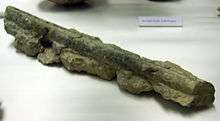Endoceras
Endoceras (Ancient Greek for "inner horn") is an extinct genus of large, straight shelled cephalopods from the Middle and Upper Ordovician that gives its name to the Nautiliod order Endocerida. The cross section in the mature portion is slightly wider than high, but is narrower laterally in the young. Sutures are straight and transverse. Endoceras has a large siphuncle, located close to the ventral margin, composed of concave segments, especially in the young but which may be tubular in the adult stage. Endocones are simple, subcircular in cross section, and penetrated by a narrow tube which may contain diaphragms reminiscent of the Ellesmerocerid ancestor.

| Endoceras Temporal range: M-U Ordovician | |
|---|---|
| Specimens in Milan | |
| Scientific classification | |
| Kingdom: | Animalia |
| Phylum: | Mollusca |
| Class: | Cephalopoda |
| Subclass: | Nautiloidea |
| Order: | †Endocerida |
| Family: | †Endoceratidae |
| Genus: | †Endoceras Hall, 1847 |
Endoceras was named by Hall in 1847. Distribution is widespread, especially in North America and Europe. Endoceras is similar to Cameroceras, the two may be synonymous, but differs from the genus Nanno in that the siphuncle in Nanno fills the entire apical portion of the shell while in Endoceras the siphuncle is ventral even there with septa formed at the onset.
Mature, full grown, Endoceras were most likely ambush predators that lay in wait on the sea floor, moving when necessary to gain the advantage. Younger individuals with compressed cross sections may have been more actively mobile.
Size
A specimen of Endoceras giganteum at the Museum of Comparative Zoology measures 3 meters (9.8 ft) as preserved[1]. The most recent estimate puts its complete size at 5.7 meters (18.7 ft). This would make it the largest cephalopod by length in the fossil record.[2] There is additionally an unconfirmed report of a 9.1 meter (30 ft) shell that was destroyed.[3]
References
- Teichert, C. 1964. Endoceratoidea; Treatise on Invertebrate Paleontology, Part K; Geol Soc of America and University of Kansas Press
- Teichert, C.; Kummel, B. (1960). "Size of endoceroid cephalopods". Breviora. 128: 1–7.
- Klug, C.; De Baets, K.; Kröger, B.; Bell, M.A.; Korn, D.; Payne, J.L. (2015). "Normal giants? Temporal and latitudinal shifts of Palaeozoic marine invertebrate gigantism and global change". Lethaia. 48 (2): 267–288. doi:10.1111/let.12104.
- Flower, R.H. (1955). "Status of endoceroid classification". Journal of Paleontology. 29 (3): 329–371. JSTOR 1300321.